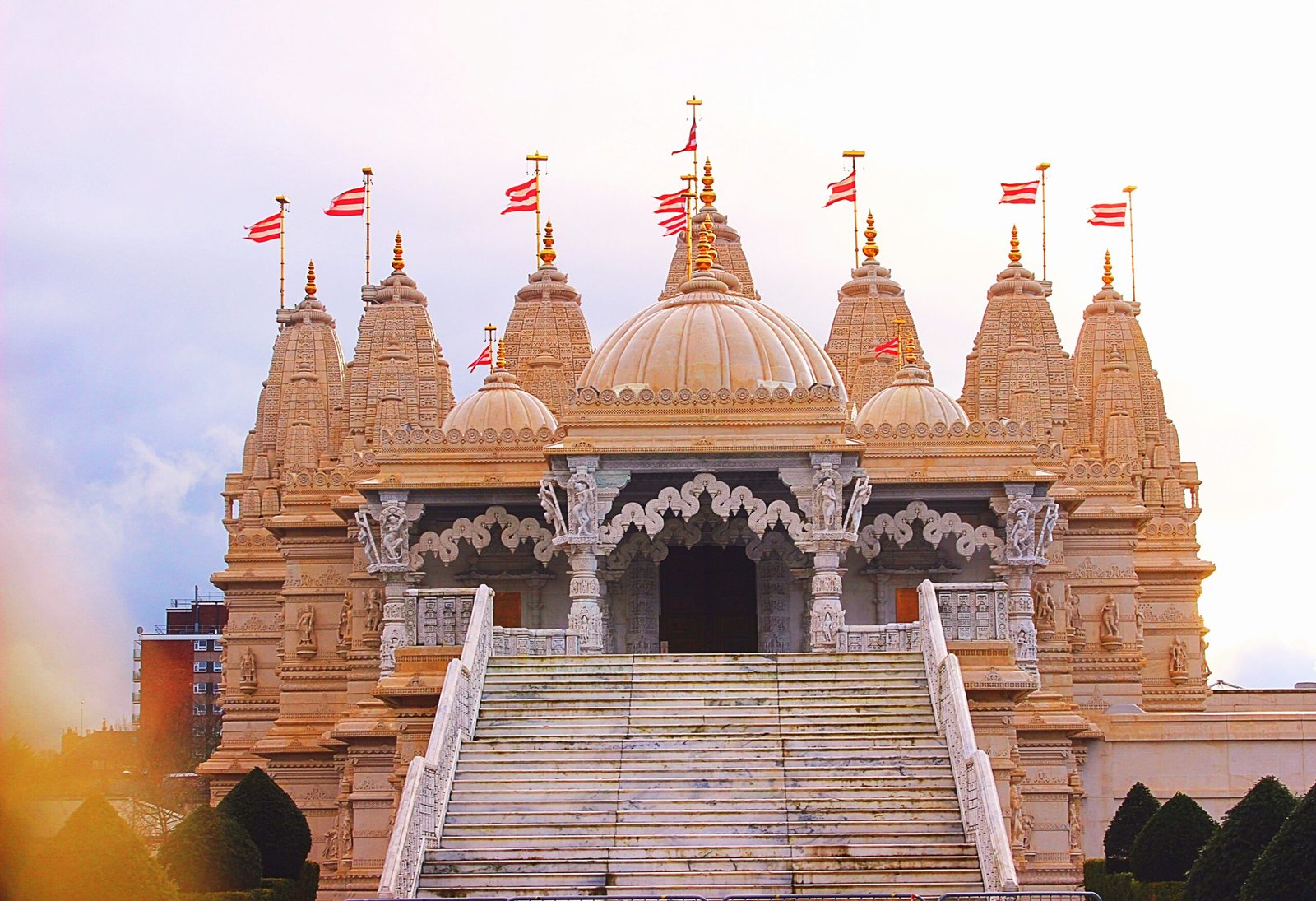Peter Spiegel has traveled numerous times to India and shared generously when we inquired about the various temples and locations he’d visited. According to Peter Spiegel, many temples in India are characterized by the fusion of architecture, history, and spirituality, culminating in an experience that is truly unforgettable.
We wanted to provide a list of incredible temple“standouts”, along with places catering to both devout pilgrims and curious travelers. We incorporated Peter’s input to provide the following list, starting with the Banke Bihari Temple in Vrindavan.
Banke Bihari Temple: The idol of Banke Bihari is said to embody the divine union of Radha and Krishna. According to history, this sacred form was revealed by Swami Haridas, a respected saint and musician of Vrindavan. He was believed to be the earthly manifestation of Lalita Gopi, one of Radha Rani’s 8 mahasakhis in Divine Vrindaban. The temple is situated near Shri Radha Vallabh Temple and is a spectacle of Rajasthani architectural grandeur. It is one of the seven temples venerating Thakur (Krishn) of Vrindavan, alongside Shri Radhavallabh Ji, Shri Govind Dev Ji, and four others.
In terms of the deity’s stance, “Bankey” signifies being “bent beautifully in three places,” while “Bihari” denotes the “supreme enjoyer.” Lord Krishna’s dietystands in the Tribhanga posture here (charmingly bent at His knees, hips, and shoulders). It is said that Haridas Swami originally worshipped the devotional image under the name Kunj-Bihari (The one who goes to and enjoys lovely garden enclosures).
Darshan timings vary by season at the Banke Bihari temple, and Peter relays that the temple and surrounding area is extremely crowded during celebrations.
Next, wehighlightKatyayaniPeeth – a place among the 51 Shakti Peethas.
KatyayaniPeeth: KatyayaniPeeth(a holy place of worship that is dedicated to Sati, or Shakti) in Vrindavan is one among 51 Shakti Peethas popularly known as Uma Shakti Peetha. Goddess Sati is worshipped here as ‘Maa Katyayani/Uma’, and Lord Shiva as ‘Bhotesh’. The temple is known for its glorious architectural sculptures and sacred rituals. A saint, Kesavanand Maharaj, an ardent devotee of Maa Katyayani, built it. One night, he dreamt that Katyayani Devi asked him to go to Vrindavan and build a temple. Navratri and Durga Puja celebrations are special occasions where devotees can immerse themselves in the festivities at these mandirs (temples).
Also in Vrindaban stands a magnificent temple that is dear to Peter’s heart – Prem Mandir.
Prem Mandir: Visitors can easilyimmerse themselves in the divine love of Radha and Krishna in this temple. Prem Mandir is a manifestation of eternal, loving devotion – thus its name, which means “The Temple of Divine Love”.Intricate carvings depicting leelas of the Bhagwatamadorn on the top outer perimeter along the temple. Deities representing the highest forms of Divine Love, Radha-Krishn and Sita-Ram are lovingly decorated and revered in Prem Mandir. On the beautiful grounds surrounding the majestic temple are jhankis (scenes) – some stationary, some animated – that invite the viewer to clearly visualize and immerse themselves in various leelas of Radha and Krishn.
Prem Mandir is maintained by Jagadguru Kripalu Parishat, an international non-profit that is an educational, spiritual, and charitable trust. The temple complex is built on a 54-acre site. The fifth Jagadguru, Kripalu Maharaj, established the temple and it opened to the public on 17 February 2012. The Satsang Hall is a 73,000 square feet, pillar-less, dome-shaped hall that can accommodate 25,000 people at a time.
Peter Spiegel highlights that Indian temples abound with a rich history. The Rangji temple also has a fascinating story behind it.
Rangji Temple: Sri Rangji Mandir is devoted to Lord Sri GodaRangamannar. Goda, also referred to as Andal was an 8th-century Vaishnava saint and Alwar who composed “Tiruppuvai”, which centers around her love for Lord Krishna. She yearned for him, observed fasts in his honor, sang melodious hymns praising his name, and dreamt of marrying him. Ranganatha, the embodiment of Lord Krishna, graciously fulfilled her wishes by accepting her as his bride. At SriRanganath Mandir, Lord Krishna assumes the groom’s role. He is adorned with a walking stick, as is customary in traditional South Indian weddings. Beside him on his right is Andal, and to his left is Garuda, the divine vehicle of Lord Krishna.
For a more off-the-beaten-path experience, Peter Spiegel mentions theNidhivan Temple, which is situated in a forest. (Nidhivan is translated to mean, “Forest of Treasures”.)Devotees believe the essence of Banke Bihari himself resides there.
Nidhivan Temple: Krishna’s Nidhivantemplein Vrindavan has a sense of mystery about it. Regarded as one of the holiest locations, Radha and Krishna are reported to visit Nidhivan in the night. It’s said that after the temple doors are shut for the evening, Lord Krishn descends with Radha and the Gopis to perform various leelas and engage in the blissful, Divine Raas Leela dance.
No one enters Nidhivan after sunset. Each evening, a sacred space called the Rang Mahal is meticulously arranged in an inviting manner. Temple priests lay out betel leaves, drinking water, and a bed of fragrant sandalwood. The Mahal is lovingly adorned with lavish offerings, in anticipation of the arrival of Radha-Krishn and the Gopis.
It is said that during Krishna’s Raas Leela, tulsi plants transform into dancing Gopis under the moonlit sky. Some even claim that residents hear the melodious, rhythmic sound of anklets emerging from the Nidhivanat night. Peter Spiegel feels that Temples in India are a treasure trove of rich history and architectural beauty – each with their unique story and mystique.
